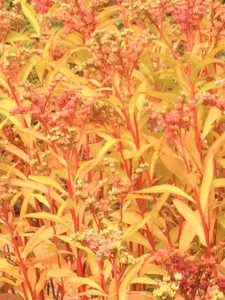 Welcome to my late autumn blog; we have enjoyed some lovely red and yellow tints on many plants, especially Penthorum sedoides, though the colours are always better on years when we get still frosty weather rather than endless gales and rain! I think the last water lily flower has gone, and except for the last few bright red flowers of Hesperantha the strong colours are over until Spring.
Welcome to my late autumn blog; we have enjoyed some lovely red and yellow tints on many plants, especially Penthorum sedoides, though the colours are always better on years when we get still frosty weather rather than endless gales and rain! I think the last water lily flower has gone, and except for the last few bright red flowers of Hesperantha the strong colours are over until Spring.
The top growth on most herbaceous plants is dying back now and most plants are going dormant. There are very few evergreen water plants, namely Acorus gramineus and cultivars, Baumea and Equisetum. There are a few others like Juncus that hold on to some green foliage too. Lastly there are the plants that do best in cooler water and go dormant in summer, such as Aponogeton , Callitriche and Water cress (Nasturtium).
This is probably a good time to explain the issue of seasonality, which seems to be a source of confusion. At this time of year we get many people asking “When will such and such a plant become available?” A guide to availability appears just below the main plant description, e.g. from Month 3 (March) to Month 10 (October). In many cases, even when the plant is shown as unavailable, they do exist here, and can be looking really good, but would be unsuitable to uproot and send for re-establishment in your pond. A good example is Ranunculus aquatilis. This oxygenating plant is grown here in flowing spring water coming directly from the ground at 11 degrees centigrade and is currently looking green and healthy, albeit the low light levels mean that the fine side branches are absent. However, if this was transferred to a pond at 4 degrees it would simply die back before roots form, and fail, so we list it as unavailable to prevent disappointment. Once Spring temperatures lift sufficiently we will make it available once more. Other plants like Houttuynia and Stachys exist only as fragile white roots in winter, these tend not to establish well if broken up in winter. Still others like Primula chungensis and P vialii retreat back to a tiny rosette or bud and are very vulnerable to rotting or damage if moved too early. Some, like frogbit (Hydrocharis) form microscopic overwintering buds in the bottom sediment and don’t become even visible until they germinate in Spring. Even then they are very tiny and it takes a few weeks for them to be big enough to sell. Others, like Cotula, regrow mostly from seed shed in late summer and the old plant will die off. Most of the other unavailable plants fall into the category of “too ugly to sell”, like Alisma, which is now just a squishy brown mass from which, improbably, tiny new shoots grow rapidly in late Spring.
All through the year there will be plants that will come and go, so it is unlikely that you will be able to purchase all your plants in one hit, though in May to July typically everything will be available subject to stock remaining. Our low carriage charge means that it will not be too painful to make several purchases at the optimum time of year for the plants concerned.
Happy water gardening, I hope to hear from you when it gets a bit warmer!
Devon Pond Plants vouchers are available for those last minute Christmas gifts. Customers can pay for these using the Vouchers and non standard payments box under Baskets and sundries!
No time limitation on using the vouchers.Devon Pond Plants vouchers are available for those last minute Christmas gifts. Customers can pay for these using the Vouchers and non standard payments box under Baskets and sundries! No time limitation on using the vouchers.


